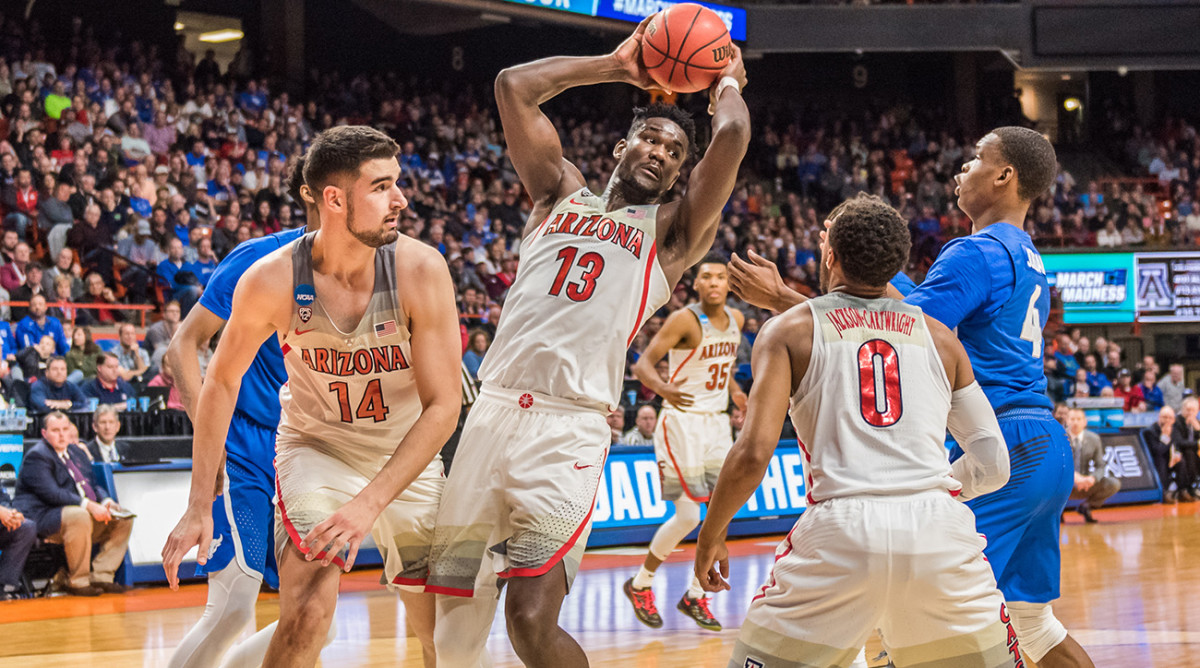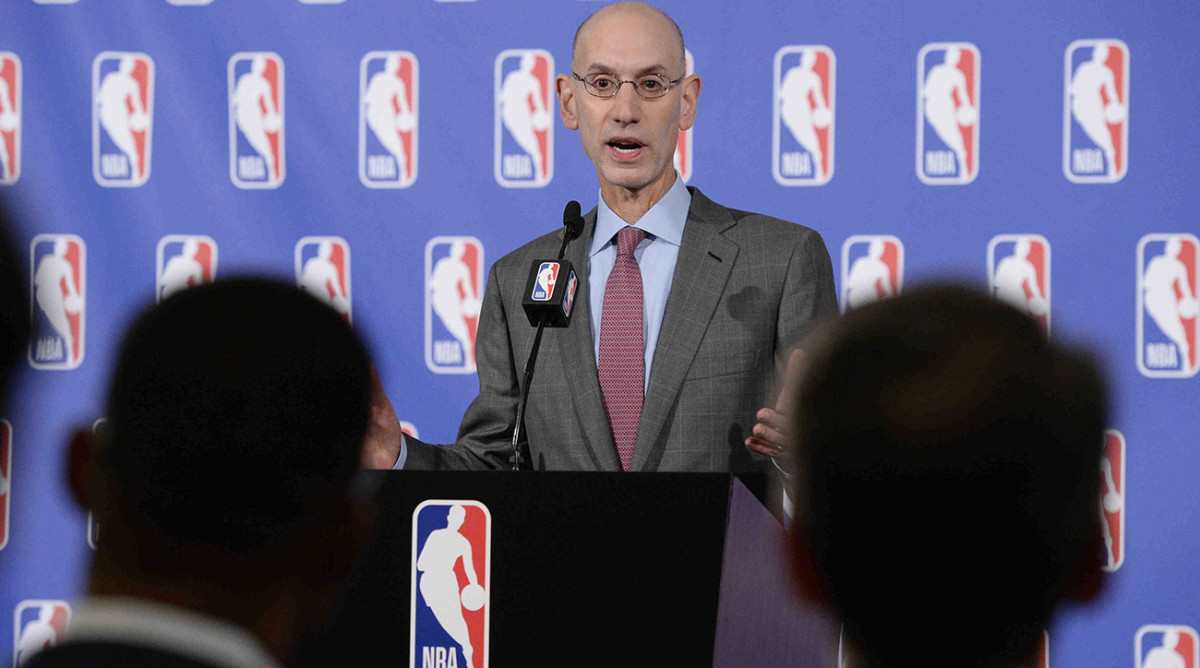How Will the NBA Respond to the Corruption in College Basketball?

Modern-day college basketball is a mess of bad rules, exploited teenagers, and black–market dealings that undermine the integrity of everyone involved. We know this. Blue Chips came out in 1994. Ricky Roe's gym bag (and tractor) taught a generation how the market works. If there's anything that's actually been destroyed by this year's sprawling FBI investigation into bag men and sneaker money, it's not the integrity of the sport, but the plausible deniability among basketball power-brokers who might otherwise ask you to believe any of this is functioning properly.
"I don't know if there's any fixing the NCAA," LeBron James said earlier this month. "I don't think there is. It's what's been going on for many, many, many, many years. I don't know how you can fix it. I don't see how you can fix it."
On the other side of the basketball spectrum, there is the NBA. While college basketball's resonance seems to be waning, the NBA's in the middle of the most prosperous era the league has ever known. And while NCAA administrators have resisted change for decades, Adam Silver's league office proposing new changes every other month. In the past year alone, the NBA has reformed the lottery, tweaked the schedule to give players more rest, revamped the All-Star Game, lobbied for legalized gambling, and floated ideas for a year-end tournament. And as Brian Windhorst and ESPN reported recently, addressing amateur hoops is next on the agenda:
"Seeing both a responsibility as the world's leading basketball league and an opportunity to move in on valuable territory, the league is preparing to get involved again with elite high school basketball players ... A plan is expected to include the NBA starting relationships with elite teenagers while they are in high school, providing skills to help them develop both on and off the court. It would ultimately open an alternate path to the NBA besides playing in college and a way 18-year-olds could earn a meaningful salary either from NBA teams or as part of an enhanced option in the developmental G League."
The details of this plan are still in flux, but the broad strokes sound awfully similar to what LeBron proposed earlier this month when he was discussing how the NBA might respond to the hopeless state of the NCAA.
"We have to shore up our G League," James said. "I just looked at it like the farm league, like in baseball. Or you look at pros overseas; some of those guys get signed at 14, but they get put into this farm system where they're able to grow and be around other professionals for three or four years. Then, when they're ready, they hit the national team. Or when they're ready, they become a pro. So I think us, we have to kind of really figure that out, how we can do that."
It makes sense in theory. College basketball already operates as a de facto semi–pro league for most elite players; the innovation from the NBA would be to take the backroom exchanges in college and move them above board, with the added bonus being that teenagers won't be compromised if they accept G League money. What's more, they'd be coached by NBA personnel, which would better prepare them for the roles they'd play in the pros. For a league that's growing every year and constantly thinking about ways to improve its business, this seems like territory that's very much worth exploring.
But while we explore, I'm wondering whether this is really the best solution. After thinking about this for a few weeks, I have six questions before the NBA proceeds.

1. How many 18-year-olds could realistically contribute in the G League? Keep in mind: the G League is comprised of players in their mid-20s. Grown men. Many of them were stars in college, and all of them have spent time getting stronger and refining their game. It's not the NBA, but the baseline of talent and athleticism in the G League is much higher than anything players would see in college. Apart from a few outliers (DeAndre Ayton, Marvin Bagley), the vast majority of teenagers would struggle to see the court in the G League, and many of them would get exposed when they did.
As one scout put it to me, "People don't realize, almost all 18-year-olds suck. They can't help any pro team. Especially not the G League. That's just the reality."
It's possible that the model would evolve and make the transition easier. If development of teenagers becomes the priority across each G League affiliate, then quality of play may suffer, but it would give top prospects more room to breathe. For now, even the elite players would be in over their head. "Ayton would get 20-10 in the G League," the scout continued. "It's a 48–minute fast–paced game. But he'd play against Matt Costello, or Cliff Alexander, or Johnny O'Bryant, and it'd be about even. Trae Young would struggle against Lorenzo Brown or Dwight Buycks."
2018 NBA Draft Big Board 5.0: Top 80 Rankings as NCAA Tournament Marches On
2. How many teenagers and their families would choose this path over college basketball and never make it to the NBA? More LeBron: "We have to figure out if a kid feels like, at 16 or 17, he doesn't feel like the NCAA is for him, or whatever the case may be, [then] we have a system in place where we have a farm league where they can learn and be around the professionals but not actually become a professional at that point in time. Not actually play in the NBA, but learn for a few years. Learn what the NBA life is about, learn how to move and walk and talk and things of that nature."
This sounds like the European model, where players spend time improving in academies. It seems like the more enlightened approach, where everyone admits early on that it's better off for 16-year-old prodigy to begin preparing for his career in earnest once it's clear that he has a future basketball. The problem is that development isn't linear. What about the kid who peaks at 17? Not every European basketball star who leaves high school actually makes it to the senior team of his club, let alone the NBA.
For every two or three players who are clearly destined for the NBA lottery, it's probably safe to assume there will be 10 other families who gamble and commit to a life in minor league basketball. Granted, those players would be paid, so that's a welcome change from college. They'd also see less playing time than they would in college, and could just as easily wash out of the pros by 22 years old, with no education, and and a limited résumé to send to pro teams in Europe.
Having said that, when I raised the last point about diminishing options, another front office executive pushed back. "If you think about it," he says, "How many of the high school players that declare won't be able to make a living playing basketball? Like, the Ball kids are overseas for Pete's sake. Even if [teenagers] flame out of the NBA, they'll likely be able to play overseas a long time." It's true: there's always Lithuania.
3. Would the G League help prospects develop better than college? This is probably the best argument for reforming the system and ushering America's best prospects through the G League. Instead of adapting to rigid college systems and various rules and stylistic quirks that don't exist in the pros, welcoming high school stars to G League would allow elite players to be guided by NBA wisdom. More space for guards, more freedom for big men, better officiating—it's a smarter approach.
Conversely: a better development environment wouldn't necessarily apply to the teenagers who aren't good enough to see the floor, and it may not change the trajectory of generational talents who would flourish regardless. For example: Because of strength deficiencies, guys like Tyler Ulis and Devin Booker probably would have struggled if they skipped Kentucky and spent a year G League. Karl Anthony-Towns probably would've handled the adjustment just fine, but would a year of G League coaching really have changed his career in a meaningful way?
With NBA–adjacent coaching, there's definitely potential for some marginal improvements in the way elite talent is developed. There's also a risk of overstating those benefits.
4. Would the G League be viable as entertainment? If the NBA is looking to create a secondary business by infusing its minor league with draft prospects and one day selling G League media rights, the proposal makes a little bit more sense. That's the valuable territory mentioned in Windhorst's ESPN report. If DeAndre Ayton could play for the Santa Cruz Warriors, obviously, more people would watch. But how big would the audience really be?
College hoops has a built-in audience who are loyal regardless of the players. Siphoning fans from, say, Kansas basketball, seems unlikely. And without that base, are 15–20 draft prospects with "enhanced" salaries really enough to make the G League a bankable product? Paying more money to prospects who turn pro early would require significant investment from teams who already complain about spending, and a pay-off from a more lucrative G League isn't guaranteed.
Another concern: With Major League Baseball currently lobbying for legislation allowing teams to pay minor leaguers less than minimum wage, it's an open question as to what "enhanced" salary options would look like for the lion's share of prospective G League entrants. Minimum wage or not, owners don't like paying a premium for players who don't generate revenue.
5. What about abolishing the age limit and allowing elite players to come straight to the NBA? If the league is ready to embrace high school players again, it's worth noting that most of today's teenagers aren't exactly thriving. Look across the NBA. Even in one of the best rookie classes in years, most one-and-done rookies are struggling to make meaningful contributions. Markelle Fultz, Lonzo Ball, Josh Jackson, Dennis Smith, Jr., Lauri Markkanen, Jonathan Isaac, De'Aaron Fox—most of them have shown flashes of star potential, but with the exception of Jayson Tatum and maybe Bam Adebayo, none of them can be counted on to contribute to a winning team at this point. It's one reason the bottom tier of the league looks so hopeless. Tanking is an ongoing problem in its own right, but the parallel truth is that teams waiting on 19-year-olds to become productive have no shot at winning anyway.
In other words, in many ways the NBA is already subsidizing the grassroots development of teenagers. That math makes sense for individual teams: the potential benefits of a 19-year-old with superstar potential exceed the cost of the two years it takes him to get acclimated. But it hurts the baseline product of the league when 8-10 teams are in that holding pattern each season. While many claim that an age limit is immoral, I'm not so sure. An age limit in the NBA is reasonable for the same reason regulations are reasonable in most capitalist markets; an unregulated free market for 18-year-old basketball players incentivizes teams to make risky long-term bets that benefit themselves at the expense of the broader basketball economy.
Really, the single biggest problem with the NBA's age-limit—the only reason morality is part of this discussion—is that the league's current rules force elite players to choose between a year of unpaid labor in the NCAA, accepting black market cash from schools/agents/shoe companies, or going overseas to play for a legal salary. That problem is real. As long as the system continues to exist in its present form, everyone involved should feel guilty.
6. What else could the NBA be doing to address the problems? Let's go back to something LeBron said about the NCAA at the beginning: "I don't know how you can fix it." I'm not sure the solutions are really so mysterious. If players in big-time college basketball (and football) could accept money that's already being offered, every conversation about the morality of college sports becomes 200% less melodramatic. So why isn't the NBA pushing colleges in that direction?
The NCAA should a) let players sign agents to represent their best interests and negotiate endorsements; b) let players capitalize on their likeness rights with money from whoever will offer it; and c) let them transfer without penalty in situations that don't work out. Under this model, it wouldn't even have to be schools themselves footing the bill for players. Plenty of sneaker companies, local businesses, and other program benefactors could emerge to compensate the handful of stars who are generating revenue and foregoing NBA salaries. We know this model can work for players because it's (allegedly) already working.

Obviously, Adam Silver isn't running the NCAA. The NBA can only do so much to make those changes a reality. Nevertheless, it's been strange to watch the league—save for LeBron and Stan Van Gundy—adopt a broadly neutral stance in this discussion. This is a league that has spent the past few years lobbying for gay rights, gun control, racial equality, and gender equality. All those movements are laudable and important, but fighting for the rights of amateur basketball players seems like a cause that hits close to home for everyone in the league.
There's already plenty of overlap between college power brokers and those in the NBA. Mike Krzyzewski rejuvenated his career working for Jerry Colangelo and USA Basketball, while NBA partners like Nike and ESPN still wield tremendous influence across the college landscape. I'm not advocating for Adam Silver to fly to Indianapolis and begin picketing outside NCAA headquarters, but there are some conversations that could probably help grease the wheels for reform behind closed doors.
Adidas's Loyalty to Louisville Goes Beyond the Terms of Its Contract
College basketball costs the NBA nothing. And maybe the answer will look different after 10 or 15 years and significant investments from all 30 teams, but right now it's still a good bet that college works better for most 18-year-old prospects than the G League would. Off the court, the experience is more rewarding, and it offers a bridge to adulthood that has real social benefits. On the court, there's more room to make mistakes and grow, competition is easier to handle, and prospective NBA stars are marketed more effectively than a minor league could ever offer.
Fixing college basketball wouldn't be easy. It wouldn't happen overnight. Along the way, it would require elite diplomacy skills from people in the NBA and various decision-makers in college. But as the FBI investigation continues to unspool, the basketball world is still in the first quarter of the reform discussion. We're in the brainstorming process. In that case, everyone should be clear-eyed about what's really possible, and what's actually the ideal solution. NCAA reform may seem unfathomable, but a popular and lucrative G League benefiting a majority of teenagers and owners isn't necessarily more realistic.
The hallmarks of Silver's time in charge have been fearlessness, creativity, and responsiveness. The boldest, most creative response to the current amateur hoops landscape is sitting right there for the league to pursue. Before the NBA gives up on college basketball, why not try to save it?
